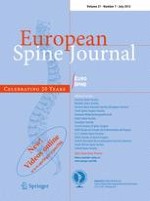Published in:

01-07-2012 | Original Article
Cross-cultural adaptation and assessment of the reliability and validity of the Core Outcome Measures Index (COMI) for the Brazilian-Portuguese language
Authors:
L. H. F. Damasceno, P. A. G. Rocha, E. S. Barbosa, C. A. M. Barros, F. T. Canto, H. L. A. Defino, A. F. Mannion
Published in:
European Spine Journal
|
Issue 7/2012
Login to get access
Abstract
Purpose
The use of patient-orientated questionnaires is of utmost importance in assessing the outcome of spine surgery. Standardisation, using a common set of outcome measures, is essential to aid comparisons across studies/in registries. The Core Outcome Measures Index (COMI) is a short, multidimensional outcome instrument validated for patients with spinal disorders. This study aimed to produce a Brazilian-Portuguese version of the COMI.
Methods
A cross-cultural adaptation of the COMI into Brazilian-Portuguese was carried out using established guidelines. 104 outpatients with chronic LBP (>3 months) were recruited from a Public Health Spine Medical Care Centre. They completed a questionnaire booklet containing the newly translated COMI, and other validated symptom-specific questionnaires: Oswestry Disability Index (ODI) and Roland Morris disability scale (RM), and a pain visual analogue scale. All patients completed a second questionnaire within 7–10 days to assess reproducibility.
Results
The COMI summary score displayed minimal floor and ceiling effects. On re-test, the responses for each individual domain of the COMI were within 1 category in 98% patients for the domain ‘function’, 96% for ‘symptom-specific well-being’, 97% for ‘general quality of life’, 99% for ‘social disability’ and 100% for ‘work disability’. The intraclass correlation coefficients (ICC2,1) for COMI pain and COMI summary scores were 0.91–0.96, which compared favourably with the corresponding values for the RM (ICC, 0.99) and ODI (ICC, 0.98). The standard error of measurement for the COMI was 0.6, giving a “minimum detectable change” (MDC95%) of approximately 1.7 points i.e., the minimum change to be considered “real change” beyond measurement error. The COMI scores correlated as hypothesised (Rho, 0.4–0.8) with the other symptom-specific questionnaires.
Conclusions
The reproducibility of the Brazilian-Portuguese version of the COMI was comparable to that of other language versions. The COMI scores correlated in the expected manner with existing but longer symptom-specific questionnaires suggesting good convergent validity for the COMI. The Brazilian-Portuguese COMI represents a valuable tool for Brazilian study-centres in future multicentre clinical studies and surgical registries.





